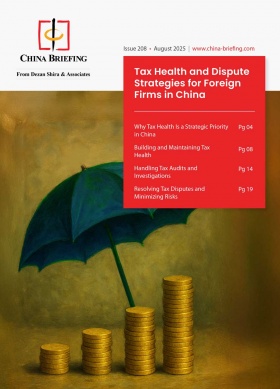China Sets 7-10% Carbon Reduction Target – Breaking Down the 2035 Climate Pledges
China’s 2035 climate pledges mark the country’s first absolute emissions reduction target, committing to cut CO2 emissions across the entire economy by 7 to 10 percent from peak levels by 2035. While the goal is modest, China’s track record and current trajectory suggest it is likely to exceed this baseline. For businesses, the pledges signal a steadily tightening regulatory environment, with growing pressure to align operations and reporting with China’s long-term decarbonization strategy.
On September 24, President Xi Jinping delivered a pre-recorded speech at the 80th UN General Assembly in New York announcing China’s 2035 climate pledges. For the first time, China set an absolute carbon reduction target, aiming to reduce CO2 emissions by 7 to 10 percent across the entire economy by 2035 from peak levels, while “striving to do better”.
As the world’s largest emitter of greenhouse gases (GHGs), China plays a critical role in keeping global warming to below 1.5°C and well below 2°C from pre-industrial levels, as set out in the Paris Agreement. As the International Energy Agency puts it, “There is no plausible path to limiting the global temperature rise to 1.5°C without China”.
The new climate targets, which China had previously stated it would release prior to the COP30 summit in Brazil in November, fulfills its commitment to set five-year Nationally Determined Contributions (NDCs) under the Paris Agreement.
China’s last set of NDCs, first announced at the 75th UN General Assembly in 2020 and adopted as official policy in 2021, include its “dual carbon goals” of reaching peak CO2 emissions by 2030 and carbon neutrality by 2060, and reducing CO2 emissions per unit of GDP by 65 percent from 2005 levels by 2030.
Breaking down China’s 2035 climate pledges
Reducing economy-wide CO2 emissions by 7 to 10 percent from peak
The decision to set an absolute emissions reduction target is the most significant of China’s 2035 climate pledges. Until now, China has set more nebulous or granular climate targets, such as reductions in energy consumption and intensity, or CO2 reduction targets for certain high-emitting industries.
While climate scientists and policy analysts have long hoped that China will set an absolute emissions reduction target, the new figures fall short of expectations. As the world’s largest emitter of GHGs in absolute terms – though not in per capita terms – there is general consensus that China would need to reduce CO2 emissions by a much higher percentage if the world is to keep to well below 2°C of warming. The Centre for Research on Energy and Clear Air (CREA) in 2024 recommended that China set an absolute emissions reduction target of 30 percent between 2023 and 2035.
The 7 to 10 percent reduction target is also set from an undefined “carbon peak”. This adds further uncertainty to the commitment, as it is not clear when this will happen, and what the level of CO2 emissions will be when it reaches its peak.
Optimistic projections suggest China could reach peak carbon emissions as early as 2025. According to analysis from the CREA for Carbon Brief, China’s CO2 emissions fell by 1 percent year-on-year in the first half of 2025, driven by a huge growth in solar power offsetting the rise in electricity demand, as well as a drop in coal use and an increase in gas consumption. This trend could continue if the country’s renewable energy uptake stays on its current trajectory. However, as noted by Carbon Brief, the very small drop in emissions means any sudden increase in energy consumption could set a new emissions record.
Conservative estimates, meanwhile, suggest China will reach peak carbon emissions by 2028, with total emissions reaching 14.5 to 15.5 GtCO2e.
The difficulty of achieving – as well as its impact on the global climate – a 7 to 10 percent emissions reduction will therefore hinge on which of these projections become reality.
Increasing non-fossil fuel consumption and installed solar and wind generation capacity
In addition to the carbon reduction target, China will aim to increase the proportion of non-fossil fuels in the country’s total energy consumption to over 30 percent. In 2024, non-fossil fuels accounted for 18.9 percent of total energy consumption, almost hitting the 2025 target of 20 percent.
Like the carbon reduction target, this goal is relatively modest. China’s current trajectory of growth in renewables and a decrease in fossil fuel use – especially coal – suggests it could increase this proportion to 40 percent by 2035.
China will also aim to increase the installed capacity of wind and solar power generation to six times 2020 levels, while striving to reach 3,600 GW by 2035.
Given the rapid pace of China’s solar and wind energy capacity build-out in recent years, the country is expected to easily reach this target. China’s total installed capacity of wind and solar in 2020 was 530 GW, which means its lower target of “six times 2020 levels” would be around 3,100 GW.
In order to reach the more ambitious target of 3,600 GW by 2035, China would need to add an average of 180 GW in new installed solar and wind capacity per year between 2025 and 2035, corresponding to a CAGR of around 9 percent. As of July of this year, China has already added 1.68 GW in new installed capacity, while in 2024, it added almost 360 GW. Between 2015 and 2024, total wind and solar capacity grew at a CAGR of almost 20 percent, far outstripping the growth rate needed for the current targets.
Forest stock volume to cover 24 billion cubic meters
Increasing forest stock volume (FSV) has been an important aspect of China’s climate and environmental policy for decades.
In 1978, China launched the “Three North Shelterbelt Forest Program” (三北防护林), also known as the Great Green Wall of China, a massive reforestation initiative designed to curb desertification, reduce soil erosion, and mitigate sandstorms in the country’s “three northern” regions. As one of the largest ecological engineering projects in the world, it has played a central role in expanding China’s forest coverage and enhancing the country’s carbon sink capacity.
In 2024, China’s FSV exceeded 20 billion cubic meters, with total forest coverage surpassing 25 percent, according to the National Forestry and Grasslands Administration (NFGA). This marks an increase from around 12.5 billion cubic meters in 2000 and 17.5 billion cubic meters in 2020, during which time forest coverage expanded from roughly 16.5 percent to 23 percent.
The pledge to increase FSV to 24 billion cubic meters by 2035 points to a moderation in the pace of afforestation. From 2000 to 2024, FSV grew at a compound annual growth rate (CAGR) of about 2 percent. Meeting the 2035 target would imply a CAGR of around 1.8 percent, reflecting a slower trajectory.
A slower build-up of forest stock means less carbon sequestration potential than in the past, placing greater pressure on reducing fossil fuel dependence and accelerating renewable energy deployment to deliver the bulk of emissions reductions.
New energy vehicles to become the main driver of new vehicle sales
In its efforts to tackle climate change and air pollution, China has massively expanded the production and adoption of new energy vehicles (NEVs). China’s transport sector alone accounts for around 10 percent of the country’s total carbon emissions, making it the third-highest emitter of CO2. It is also a significant source of pollutants, with total pollutants – including carbon monoxide, sulphur dioxide, and hydrocarbons – from mobile sources reaching 19.3 million tonnes in 2023, according to the Ministry of Ecology and Environment (MEE).
Over the past decade, China has become the global leader in the production of new energy vehicles (NEVs). The growth of the industry, which includes hybrid vehicles, pure electric vehicles (such as battery EVs and solar vehicles), fuel cell electric vehicles, and hydrogen engine vehicles, has been largely driven by a range of incentive policies and government subsidies, as well as support for battery production, EV parking, and charging stations. This has resulted in the manufacturing of almost 12.89 million NEVs in 2024, surging 34.4 percent from the previous year.
It is not clear from the current policy what the threshold will be for making NEVs the “main driver” of NEV sales. However, if we take conservative view and say it means NEVs will make up the majority of new vehicle sales, then China is almost already there. Purchase tax exemptions and trade-in schemes have served to greatly lower barriers to NEV adoption, massively driving up domestic sales in recent years. In 2024, sales of NEVs in China reached 12.87 million, almost entirely covering the country’s output and accounting for 40.9 percent of all new vehicle sales – jumping 9.3 percentage points from 2023.
The upshot is that China is already firmly on the path toward making NEVs the “main driver” of new vehicle purchases, and, especially given the vague wording, it is almost a certainty that it will be able to hit this target by 2035.
Expanding the national emissions trading system to cover all main emitting industries
Under the new NDCs, China has committed to expanding its national carbon emissions trading system (ETS) to cover all major high-emissions industries. China’s current ETS, which was launched in 2021, only covers “key emissions units” (companies whose annual GHG emissions exceed 26,000 tonnes of CO2 equivalent (CO2e)) in four industries: power generation, cement, steel, and aluminum smelting. This means the current system covers around 7 billion tonnes of CO2e, or around 60 percent of China’s total CO2 emissions.
China has already committed to expanding the ETS to cover more high-emitting industries. A set of official opinions released in August of this year stated that the ETS will cover all major carbon-emitting industrial sectors by 2027. While it has not yet specified which industries this would be, it could include hard-to-abate sectors such as petrochemicals, nonferrous metals, building materials, and aviation.
The main difference between the NDC pledge and the target set in the opinions is that the new pledge commits to expand the ETS to cover all high-emitting sectors, suggesting it will be expanded to include non-industrial high-emitting industries, which could include sectors such as transport and shipping.
In its current form, China’s ETS faces a number of other limitations that are not addressed by the NDCs. Companies covered by the system are given free carbon emissions allowances (CEAs) based on an intensity and efficiency-based system. Moreover, only companies in the power generation sector are currently subject to a total cap on the volume of CEAs. While this system enables easy compliance, it is ineffective in incentivizing decarbonization as it keeps CEA prices low (in August 2025, CEA prices in China were around US$10). Moreover, the system currently does not have an absolute emissions cap, meaning companies can continue to maintain high production without significantly reducing absolute emissions.
The opinions address these issues by requiring that the ETS sets a total emissions cap for all of the industries covered, and introducing a phased transition to CEA caps, with a firm limit on total volume to be set by 2030 (incorporating a mix of free and paid allowances).
Under-promising, over-delivering
The overall picture that emerges from China’s new NDCs is one of strategic cautiousness. The country has set itself easily achievable goals that it is likely to significantly exceed.
China often adopts this cautious approach to its policy commitments, whether economic or environmental, meaning it has a tendency to over-deliver on its promises. This can provide some comfort to those who are concerned that the current targets are not enough to stave off the worst effects of climate change, as the goals likely represent a baseline of what China can achieve, rather than the ceiling.
There is some precedence for this optimistic view. For instance, China pledged to increase total solar and wind installed capacity to 12 GW by 2030, a target it had exceeded by July of 2024. Similarly, in 2021, China set a target to increase total new energy installed capacity to 30 GW by 2025. By the end of 2024, it had reached 73.76 GW.
It now also appears possible that it will reach its carbon peak well before 2030, if current trends in renewables build-out and consumption continue.
China’s cautious approach is likely to have been informed by experience of the COVID-19 pandemic, and in particular the impact that the post-COVID recovery had on energy needs and usage. Severe energy crunches in 2021 and 2022, compounded by a surge in economic activity and energy demand during the recovery, led to the opening of new coal projects, creating temporary setbacks for China’s environmental commitments. In part as a result of this, China is likely to miss its target of cutting energy and carbon intensity by 13.5 percent and 18 percent, respectively, between 2020 and 2025, set in its 14th Five-Year Plan.
It is impossible to foresee further setbacks like these, and China is likely to be hedging its bets by setting easily achievable targets while building excess capacity in renewables to buffer against unexpected shocks.
Regardless of what China’s climate pledges are, its commitment to the green energy transition is unmistakable. In his speech to the UN General Assembly, Xi emphasized that “the green and low-carbon transition is the trend of our times.” China’s green energy ambitions are also driven by a desire for greater self-sufficiency and energy security, giving additional impetus and urgency to the country’s investment in renewables, grid upgrades, and clean technology innovation.
What China’s 2035 climate pledges mean for business
China’s new climate targets are in themselves unlikely to have a direct and immediate impact on businesses in the country. More broadly, however, China’s commitment to the green transition and decarbonization will have significant long-term implications for companies, which will have to contend with stricter environmental regulations, reporting requirements, and ESG obligations.
2026 will mark the first year of China’s 15th Five-Year Plan, a critical document that will shape the country’s economic and development policies through the end of the decade. This plan is expected to provide additional details on China’s climate targets and environmental policy in the period from 2026 to 2030, and will almost certainly set the tone for how the dual carbon goals are operationalized in practice.
Even before the latest climate pledges, China had been gradually moving toward a model of curbing total emissions, rather than focusing solely on energy or emissions intensity. In 2023, the government approved a policy directive to shift one of its core decarbonization strategies from focusing on a “dual energy consumption control” mechanism (能耗双控), in which the country aims to control total energy consumption and energy intensity, to a “dual control of carbon emissions” mechanism (碳排放双控), which focuses on controlling total carbon emissions and carbon emissions intensity. This shift is significant because it redirects incentives for companies from simply utilizing less energy, regardless of the source, to adopting cleaner energy sources.
For businesses, this evolution of China’s climate policy means that future competitiveness will depend on both increased efficiency and investment in low-carbon technologies, renewable energy sourcing, and transparent carbon reporting. Companies that act early to align with the new policy direction are better positioned to stay ahead of tightening regulatory requirements, avoid compliance risks, and adapt smoothly as the policy environment becomes more demanding.
About Us
China Briefing is one of five regional Asia Briefing publications. It is supported by Dezan Shira & Associates, a pan-Asia, multi-disciplinary professional services firm that assists foreign investors throughout Asia, including through offices in Beijing, Tianjin, Dalian, Qingdao, Shanghai, Hangzhou, Ningbo, Suzhou, Guangzhou, Haikou, Zhongshan, Shenzhen, and Hong Kong in China. Dezan Shira & Associates also maintains offices or has alliance partners assisting foreign investors in Vietnam, Indonesia, Singapore, India, Malaysia, Mongolia, Dubai (UAE), Japan, South Korea, Nepal, The Philippines, Sri Lanka, Thailand, Italy, Germany, Bangladesh, Australia, United States, and United Kingdom and Ireland.
For a complimentary subscription to China Briefing’s content products, please click here. For support with establishing a business in China or for assistance in analyzing and entering markets, please contact the firm at china@dezshira.com or visit our website at www.dezshira.com.
- Previous Article Key Regulatory Developments in China’s F&B Sector: Implications for Industry Stakeholders
- Next Article Breaking Down the US-China Trade Tariffs: What’s in Effect Now?








